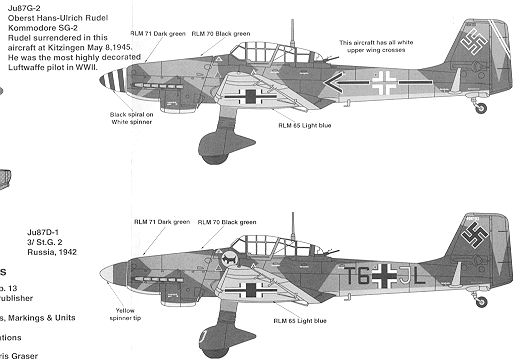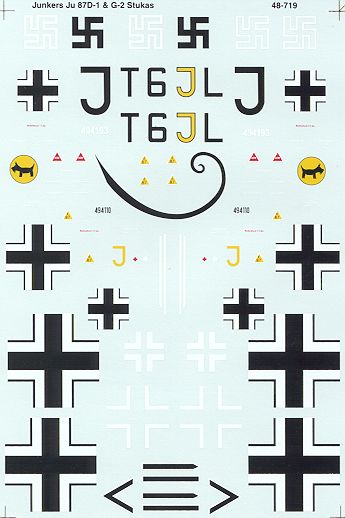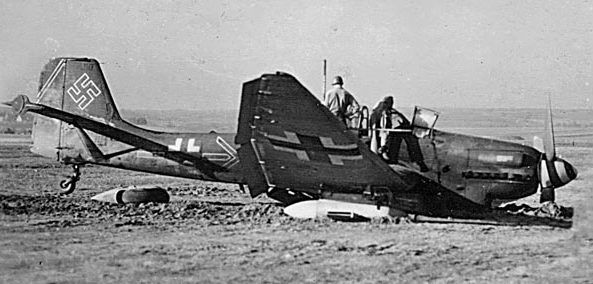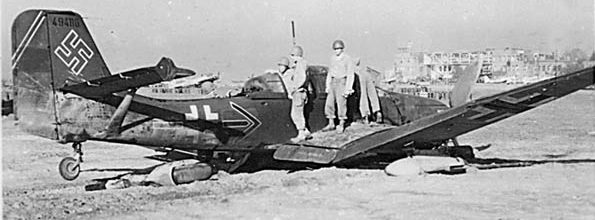
|
SHEET: |
Superscale 48-719 for Ju-87D-1 & G-2 Stuka |
|
PRICE: |
$ |
|
UNITS: |
See Review |
|
REVIEW & |
|
|
NOTES: |
` |

 Even though the
Stuka had proven to be a bust against opposition as shown during the Battle for
Britain, it was still a very potent offensive weapon when local air superiority
was maintained. For that reason, it was found to be quite effective in the vast
expanses of Russia as well as in the Balkans and, for a while, in North Africa.
Even though the
Stuka had proven to be a bust against opposition as shown during the Battle for
Britain, it was still a very potent offensive weapon when local air superiority
was maintained. For that reason, it was found to be quite effective in the vast
expanses of Russia as well as in the Balkans and, for a while, in North Africa.
However, before its faults were discovered, the Junkers factory developed an improved stuka which had a more powerful Jumo 211J engine and several aerodynamic improvements such as a more streamlined canopy, wheel covers and stabilizer supports. In addition, the oil coolers were moved from above the engine to under the wings. Armor plating and armament was also improved. Not only was the aircraft able to carry larger bomb loads, but provisions for underwing armament pods were also provided. In the later versions, dive brakes were removed and twin 37mm cannon were installed. These cannon were extremely effective against Russian armor.
Superscale's sheet provides markings for two Ju-87s. Both are in a splinter scheme of RLM 70/71 over RLM 65. Though both of them operated in the eastern front, neither of them carries the typical yellow bands and other markings typical of that theatre of operations.

The first plane is of famed tank 'ace' Han-Ulrich Rudel. Rudel is probably the most decorated German soldier of the war. He was recipient of the highest award offered by the Germans, the Knight's Cross with Golden Oak Leaves. Rudel was credited for over 500 tanks, a number of aircraft, and a Russian battleship! This particular aircraft is the last one he flew. When ordered to surrender to the Allies, he deliberately crash landed his aircraft to keep it from being used again. As you can see from the photos, he was carrying the underwing cannon at the time
 This particular
plane is rather unique in several ways. For one thing, it carries fighter type
kommodore fuselage markings that were almost never seen on Stukas. It also has a
white spiral on the spinner, another item also normally seen on fighters.
Finally, it has plain white upper wing and fuselage crosses, items not normally
seen on Stukas. I have included a couple of photographs of this plane courtesy
of the Stan Davis/Graser Collection. You'll note that Superscale has the
correct serial number on its sheet. There has been much doubt as to the right
one and so you'll see other sheets with it listed differently.
This particular
plane is rather unique in several ways. For one thing, it carries fighter type
kommodore fuselage markings that were almost never seen on Stukas. It also has a
white spiral on the spinner, another item also normally seen on fighters.
Finally, it has plain white upper wing and fuselage crosses, items not normally
seen on Stukas. I have included a couple of photographs of this plane courtesy
of the Stan Davis/Graser Collection. You'll note that Superscale has the
correct serial number on its sheet. There has been much doubt as to the right
one and so you'll see other sheets with it listed differently.
The second aircraft is from StG 2 in Russia, circa 1942. This Ju-87D-1 is marked in a very similar manner to the previous B models with large codes and unit badges. Later in the war, these markings were very much reduced or removed.
Both schemes are quite nice and will look great on your next Hasegawa Stuka.
Review copy courtesy of
 . Thanks for your support.
. Thanks for your support.
This and other new sheets are currently available at your local hobby shop.
If you would like your product reviewed fairly and quickly by a site that averages thousands of visits a day, please contact me or see other details in the Note to Contributors.